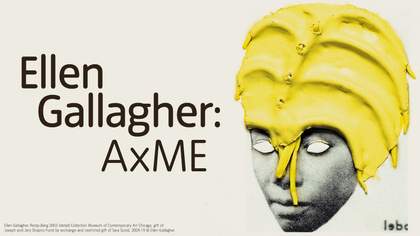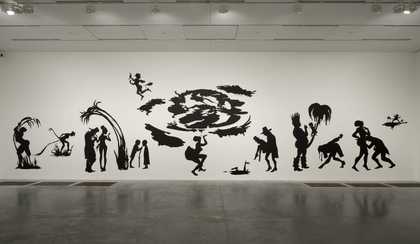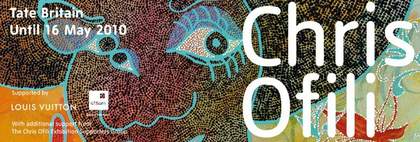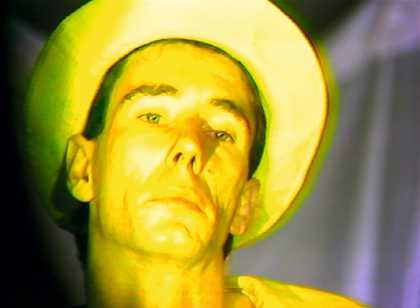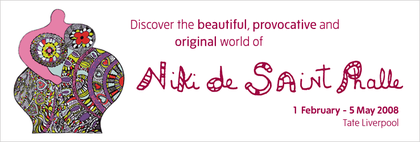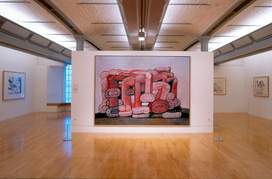The grotesque got its name by mistake. When, one day in fifteenth-century Rome, a young man fell into a hole in a hillside, he assumed he’d discovered a Roman grotto. He fetched a lantern and found wild frescoes over the grotto’s walls: half-human, half-animal figures, with legs and arms transforming into curling vines or ornamental volutes. In fact, he had stumbled upon Nero’s buried Villa Aurea, the raised floor level giving the rooms a grotto-like appearance. Nevertheless, the term ‘grotteschi’ stuck as a label for this newly discovered style that radically dissented from the classical restraint to which the Renaissance had hitherto adhered.
Conceptions of the grotesque have gone through many incarnations over the years, but something of this muddled etymology still persists. Whether one is talking about the carnivalesque use of the term, as expounded by Mikhail Bakhtin in his analysis of the Renaissance writer François Rabelais, or Wolfgang Kayser’s Romantic notion of it as something ‘ominous, nocturnal and abysmal’, the grotesque belongs underground. It is subversive, rudely transgressing the boundaries between inside and out, above and below, elevated and profane. It has to do with the corporeal subterranea – the guts and the bowels, and the processes through which internal juices are ejected into the world.
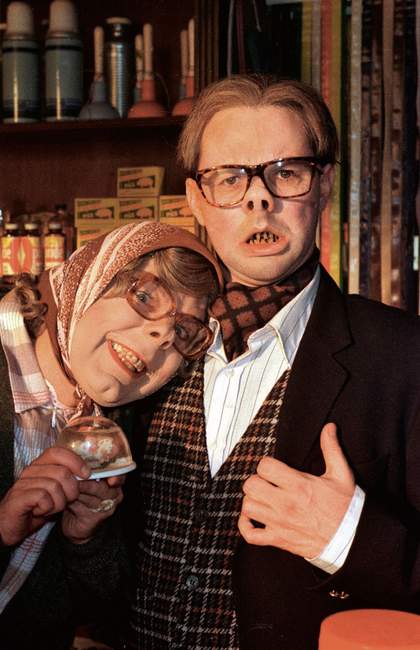
Steve Pemberton as Tubbs and Reece Shearsmith as Edward in The League of Gentlemen (2000)
© BBC, Photograph Nick West
Little wonder that the grotesque is as popular today as it was in the fifteenth century. It allows us to get (at least a partial) handle on some of the most unspeakably vile and frightening categories of human experience, and it does so with humour and a sense of the absurd. Despite remaining distinct from comedy (which, unlike the alienating grotesque, is a convivial and socially cohesive genre), it has contributed to some of the most intelligent television and film comedy of recent years. Think especially of The League of Gentlemen, but also South Park, Little Britain and the work of Steve Coogan and Chris Morris; not all caricature is grotesque, but when bodies are defiled or grossly exaggerated (with prosthetics, for instance) they become more disturbing than simple parodies. There is no easy laughter here.
The grotesque never strays far from popular culture. Perhaps that is where it draws its danger – by queering those subjects closest to home. Onetime collaborators Mike Kelley and Paul McCarthy are twin titans of the grotesque in contemporary art, and while their approaches to it are quite different, their visions are both filtered through the detritus of daily life – foodstuffs, cartoons, film and TV.
Kelley’s approach was specifically Bakhtinian. His Extracurricular Activity Projective Reconstruction series 2006–11 consists of elaborate reinterpretations of dress-up days, carnivals, Halloweens and fantasy rituals that he found photographed in high-school yearbooks. He was fascinated by the ways in which ordinarily suppressed desires seep through the surfaces of such scenarios. Caves and grottos were also always significant places for him. At the time of his death, Kelley was working on a reconstruction of his childhood home, to be sited next to the Museum of Contemporary Art in Detroit. Beneath it, he planned to dig out a labyrinth of spaces for ‘private rites of an aesthetic nature’ – mysterious activities that one might well imagine to encroach on the grotesque.
McCarthy, in contrast, is preoccupied with the bodily rather than the social grotesque. The characters that populate his films, performances and sculptures move beyond caricatures – rather, as in the case of his depictions of the cartoon character Alfred E. Neuman (Bossy Burger 1991) or George W. Bush (Train, Mechanical 2003–9), they are caricatures of caricatures. The latter, an animatronic sculpture of two Bush-headed figures sodomising two cartoon pigs, dodges first impressions of coarse political satire when one realises that the hybrid figures are actually part president, part Disney cartoon pirate and part casts of the artist’s own torso. Uncertain laughter at an uncertain body has long been a hallmark of the grotesque.
Many of McCarthy’s projects involve the construction of sets in which he is filmed engaging in exuberantly transgressive behaviour (the sets often remaining in the gallery as evidence). They are not so different in status from the “grotto” of Nero’s villa, nor from Kelley’s deviant basement. The fibreglass rocks of Kaari Upson’s Grotto 2008–9 also provided shelter for the artist, who, wearing enlarged prosthetic breasts and a silicone vagina, inhabited various female stereotypes and participated in a phone-sex role play, Jungian therapy (also over the phone) and other rambling monologic diatribes. Upson’s alter egos are grotesques – not caricatures – and to spy on them in videos installed subsequently within the grotto is a profoundly disquieting experience.
Describing the activities of the artist group gelitin as performances isn’t always accurate, especially when members of the audience are invited to join in. Sweatwat 2005 was an installation for which viewers took off their clothes, donned towels and climbed into a gallery space that was filled, ankle deep, with water. Piles of furniture, an obscene sculptural fountain and a home-made sauna crowded the space; the pipes from a transparent elevated toilet ran past the heads of visitors who were invited to sit and drink yellow cider with the artists. During the course of the exhibition, the gallery was a place where the boundaries between inside and out, viewer and artist, subject and object, clean and dirty were gleefully – and liberatingly – violated.
Visitors to Ryan Trecartin’s exhibition Any Ever 2011 entered carpeted and furnished rooms in order to watch his frenetic videos. Trecartin’s infatuation with adolescence lends itself to the bedroom as a site of private play-acting and experimentation (the teenage grotto), and his films often appear to have been shot in such places. The critic Peter Schjeldahl has likened him not to masters of filmic transgression such as Jack Smith and John Waters, but to Cindy Sherman, whose photographs of herself in disguise feature regularly in lectures on the Freudian uncanny, a close cousin of the grotesque. (Sherman, in heavy make-up and dyed hair, is uncanny; Trecartin, gabbling at the camera in bright yellow face paint with gold teeth, is grotesque.)
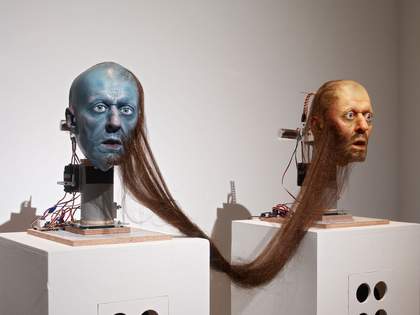
Nathaniel Mellors, Hippy Dialectics (Ourhouse) 2010
Animatronic sculpture with sound
Dimensions variable
© Nathaniel Mellors, courtesy Matt's Gallery, London
Photograph © Steve White
Also trampling across the line between the uncanny and the grotesque are Nathaniel Mellors’s lifelike animatronic sculptures, cast from the faces of actors in his films. Often they are programmed to deliver lines from the films themselves. Hippy Dialectics (Ourhouse) 2010 consists of twin faces connected by a long swag of hair. In the accompanying episodic film Ourhouse (ongoing from 2010), a character called The Object visits a family and proceeds to eat – and excrete – all their books. (Notice how the family home provides the setting for so many of these works.)
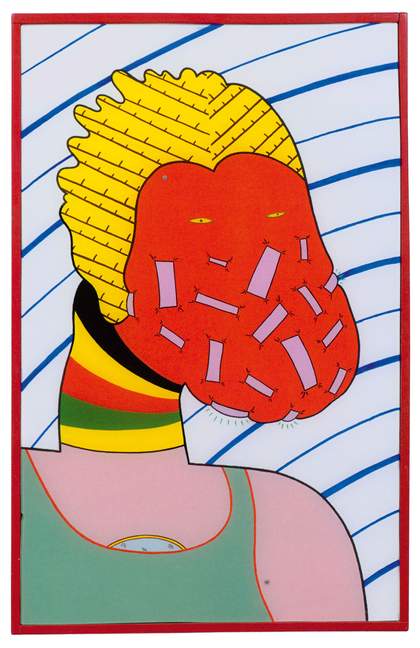
Jim Nutt Her Face Fits 1968
Acrylic on Plexiglas
Enamel on wood frame
66 x 43.2cm
© Jim Nutt, courtesy Keran Lennox Gallery, Chicago
Photograph © Museum of Contemporary Art, Chicago
The grotesque is thriving not only in contemporary performance and video-based work. Depictions of grotesque bodies have a rich heritage in painting and drawing. There is a particular sensibility that can be traced from the introduction of cartoon imagery into modernist painting in the 1960s – when Philip Guston made the leap from Abstract Expressionism to cloddish pictures of heads with massive single eyes, or hairy pointing fingers. Jim Nutt, Peter Saul, Erró and John Wesley all similarly embraced lowbrow sources, and exploited the ordinarily innocuous tone of comic book characters to summon visions of derangement and dysfunction, often sexual in nature. (Within the world of bona fide cartooning, Basil Wolverton and Robert Crumb had themselves already been bombarding the defences of taste and decency since the 1950s and 1960s.) The heirs to this generation arrived in the 1980s – painters such as Carroll Dunham, George Condo and John Currin, who flagrantly polluted overt references to historical art (fine academic portraiture in particular) with pop cultural allusions. For obvious reasons, the history of the grotesque is intimately entangled with the theorisation of postmodernism.
Not only are these painters all men, but their work tends towards provocatively sexualised depictions of women. That’s not to say that their art is necessarily misogynistic – the later generation were all schooled in feminist debates around representations of gender, and to a greater or lesser extent work with their tongues in their cheeks – but these paintings’ grotesqueries reveal some conflicted attitudes towards their feminine subjects. (When women Pop artists, such as Dorothy Lannone or Niki de Saint Phalle, made equivalently sexualised work in the 1960s and 1970s, their images were graphically arresting, stylish and strident, but never grotesque.)
So it came to pass that a number of female painters began to make grotesque pictures of women, partly in riposte to the masculine domination of the genre. Lisa Yuskavage, Cecily Brown, Jenny Saville, Sue Williams and, more recently, Dana Schutz, Nicola Tyson, Nicole Eisenman and Tala Madani have all moved to reclaim the feminine grotesque. Yuskavage’s tenderly crafted paintings recall the fleshy excesses of 1970s soft-core pornography; her ambivalence about her confrontational subjects (none of whom seems to think themselves victims) is what makes them compelling. Schutz, Eisenman, Tyson and Madani make as many paintings of men as they do of women; however, their painterly puncturing of semi-abstract bodies (dissolving them, piercing them, exploding them) undermines the cohesive integrity traditionally ascribed to the fully functioning, autonomous masculine physique.
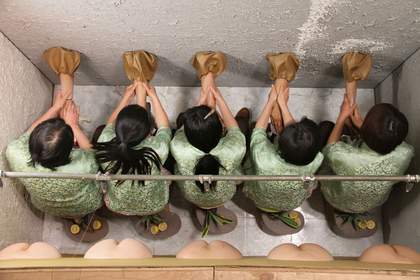
Still from Mika Rottenberg's Squeeze 2010
Single channel video installation
© Mika Rottenberg, courtesy Nicole Klagsbrun Gallery, New York, and Andrea Rosen Gallery, New York
As conversations around representations of gender have become more nuanced and subjective in recent years, so too have the ways in which artists choose to respond to them. Mika Rottenberg, Nathalie Djurberg and Stanya Kahn would all probably identify as feminists, but their performances, videos and animations stray far beyond standard dogma. They share a sensitivity to the interior experience of the female body, and the ways in which that inner space projects into the outside world (those boundaries again). In Rottenberg’s films, such as Dough 2006 or Squeeze 2010, large-bodied women are pushed by – and push into – holes and gaps in the strangely interactive architecture of her sets. Djurberg uses clay as a mutable analogue for human (and animal) bodies in her animated fantastical films. In her video Arms are Overrated 2012, Kahn’s wisecracking protagonists are made of crumbled sheets of paper. These artists portray the human form as nothing more than unstable material waiting to be reshaped by forces outside of its control – what Bakhtin called ‘the ever unfinished, ever creating body’.
The grotesque is an unpredictable firing weapon. When deployed, it usually sprays its buckshot on to more than one target. Artists of colour have made grotesques out of racial stereotypes in order to provoke viewers with questions not only about race, but also gender, sexuality, class, political power and historical record. Rarely, if ever, do they offer their own answers. Kara Walker, Chris Ofili, William Pope L and Ellen Gallagher are most often associated with this strategy. Gallagher, whose signature collaged motifs include bulging eyes, huge lips and Afro wigs (stolen from racist historical caricatures), has said that her art is not intended to be ‘corrective’. Part of these artists’ ambivalence derives from the fact that they have trouble identifying with the stereotypes themselves. As always with the grotesque, the ill-defined distinction between self and other is a source of much anxiety.
The characters in Kalup Linzy’s videos, which approximate television soap operas, are often voiced or acted by Linzy himself. Like Walker, Ofili, Pope L and Gallagher, he takes on ludicrous racially specific caricatures and presents them half ironically, half sympathetically. Perhaps it makes less sense, however, to align Linzy’s project with African-American precedents than to that of a (white) artist such as Upson, who also trades in stereotypes, or to Trecartin, whose films articulate queer sensibilities and concerns, or to Mellors, who draws so widely from television. These structurally unsound categories begin to crumble under their own weight.
In reality, the grotesque, as the art historian Frances Connelly has written, ‘does not exist except in relation to a boundary, convention or expectation’. There’s no such thing as a single grotesque. Thankfully, there will never be a shortage of boundaries or expectations for it to offend.

